Chocolate
Chocolate or cocoa is a food made from roasted and ground cacao seed kernels that is available as a liquid, solid, or paste, either on its own or as a flavoring agent in other foods. Cacao has been consumed in some form since at least the Olmec civilization (19th–11th century BCE),[1][2] and the majority of Mesoamerican people, including the Maya and Aztecs, made chocolate beverages.[3]
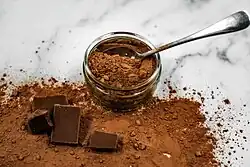 | |
| Region or state | Mesoamerica |
|---|---|
| Main ingredients | Cocoa bean |
| Variations | Chocolate liquor, cocoa butter, cocoa solids, solid chocolate |
The seeds of the cacao tree have an intense bitter taste and must be fermented to develop the flavor. After fermentation, the seeds are dried, cleaned, and roasted. The shell is removed to produce cocoa nibs, which are then ground to cocoa mass, unadulterated chocolate in rough form. Once the cocoa mass is liquefied by heating, it is called chocolate liquor. The liquor may also be cooled and processed into its two components: cocoa solids and cocoa butter. Baking chocolate, also called bitter chocolate, contains cocoa solids and cocoa butter in varying proportions without any added sugar. Powdered baking cocoa, which contains more fiber than cocoa butter, can be processed with alkali to produce Dutch cocoa. Much of the chocolate consumed today is in the form of sweet chocolate, a combination of cocoa solids, cocoa butter, or added vegetable oils and sugar. Milk chocolate is sweet chocolate that additionally contains milk powder or condensed milk. White chocolate contains cocoa butter, sugar, and milk, but no cocoa solids.
Chocolate is one of the most popular food types and flavors in the world, and many foodstuffs involving chocolate exist, particularly desserts, including cakes, pudding, mousse, chocolate brownies, and chocolate chip cookies. Many candies are filled with or coated with sweetened chocolate. Chocolate bars, either made of solid chocolate or other ingredients coated in chocolate, are eaten as snacks. Gifts of chocolate molded into different shapes (such as eggs, hearts, and coins) are traditional on certain Western holidays, including Christmas, Easter, Valentine's Day, and Hanukkah. Chocolate is also used in cold and hot beverages, such as chocolate milk and hot chocolate, and in some alcoholic drinks, such as creme de cacao.
Although cocoa originated in the Americas, West African countries, particularly Côte d'Ivoire and Ghana, are the leading producers of cocoa in the 21st century, accounting for some 60% of the world cocoa supply.
With some two million children involved in the farming of cocoa in West Africa, child slavery and trafficking associated with the cocoa trade remain major concerns.[4][5] A 2018 report argued that international attempts to improve conditions for children were doomed to failure because of persistent poverty, the absence of schools, increasing world cocoa demand, more intensive farming of cocoa, and continued exploitation of child labor.[4]
History
Mesoamerican usage

Chocolate has been prepared as a drink for nearly all of its history. For example, one vessel found at an Olmec archaeological site on the Gulf Coast of Veracruz, Mexico, dates chocolate's preparation by pre-Olmec peoples as early as 1750 BC.[6] On the Pacific coast of Chiapas, Mexico, a Mokaya archaeological site provides evidence of cocoa beverages dating even earlier to 1900 BC.[7][6] The residues and the kind of vessel in which they were found indicate the initial use of cocoa was not simply as a beverage; the white pulp around the cocoa beans was likely used as a source of fermentable sugars for an alcoholic drink.[8]

An early Classic-period (460–480 AD) Maya tomb from the site in Rio Azul had vessels with the Maya glyph for cocoa on them with residue of a chocolate drink, which suggests that the Maya were drinking chocolate around 400 AD.[9] Documents in Maya hieroglyphs stated that chocolate was used for ceremonial purposes in addition to everyday life.[10] The Maya grew cacao trees in their backyards[11] and used the cocoa seeds the trees produced to make a frothy, bitter drink.[12]
By the 15th century, the Aztecs had gained control of a large part of Mesoamerica and had adopted cocoa into their culture. They associated chocolate with Quetzalcoatl, who, according to one legend, was cast away by the other gods for sharing chocolate with humans,[13] and identified its extrication from the pod with the removal of the human heart in sacrifice.[14] In contrast to the Maya, who liked their chocolate warm, the Aztecs drank it cold, seasoning it with a broad variety of additives, including the petals of the Cymbopetalum penduliflorum tree, chili pepper, allspice, vanilla, and honey.
The Aztecs were unable to grow cocoa themselves, as their home in the Mexican highlands was unsuitable for it, so chocolate was a luxury imported into the empire.[13] Those who lived in areas ruled by the Aztecs were required to offer cocoa seeds in payment of the tax they deemed "tribute".[13] Cocoa beans were often used as currency.[15] For example, the Aztecs used a system in which one turkey cost 100 cocoa beans[16] and one fresh avocado was worth three beans.[17]
The Maya and Aztecs associated cocoa with human sacrifice, and chocolate drinks specifically with sacrificial human blood.[18][19] The Spanish royal chronicler Gonzalo Fernández de Oviedo y Valdés described a chocolate drink he had seen in Nicaragua in 1528, mixed with achiote: "because those people are fond of drinking human blood, to make this beverage seem like blood, they add a little achiote, so that it then turns red. ... and part of that foam is left on the lips and around the mouth, and when it is red for having achiote, it seems a horrific thing, because it seems like blood itself."[19]
Adaptation outside Mesoamerica
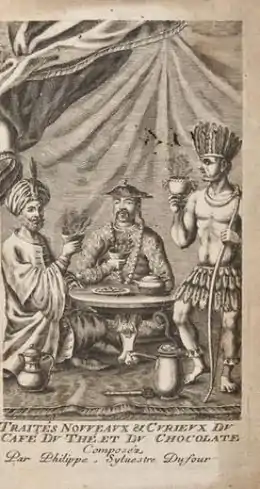
Until the 16th century, no European had ever heard of the popular drink from the Central American peoples.[13] Christopher Columbus and his son Ferdinand encountered the cocoa bean on Columbus's fourth mission to the Americas on 15 August 1502, when he and his crew stole a large native canoe that proved to contain cocoa beans among other goods for trade.[20] Spanish conquistador Hernán Cortés may have been the first European to encounter it, as the frothy drink was part of the after-dinner routine of Montezuma.[9][21] José de Acosta, a Spanish Jesuit missionary who lived in Peru and then Mexico in the later 16th century, wrote of its growing influence on the Spaniards:
Although bananas are more profitable, cocoa is more highly esteemed in Mexico... Cocoa is a smaller fruit than almonds and thicker, which toasted do not taste bad. It is so prized among the Indians and even among Spaniards... because since it is a dried fruit it can be stored for a long time without deterioration, and they brings ships loaded with them from the province of Guatemala... It also serves as currency, because with five cocoas you can buy one thing, with thirty another, and with a hundred something else, without there being contradiction; and they give these cocoas as alms to the poor who beg for them. The principal product of this cocoa is a concoction which they make that they call "chocolate", which is a crazy thing treasured in that land, and those who are not accustomed are disgusted by it, because it has a foam on top and a bubbling like that of feces, which certainly takes a lot to put up with. Anyway, it is the prized beverage which the Indians offer to nobles who come to or pass through their lands; and the Spaniards, especially Spanish women born in those lands die for black chocolate. This aforementioned chocolate is said to be made in various forms and temperaments, hot, cold, and lukewarm. They are wont to use spices and much chili; they also make it into a paste, and it is said that it is a medicine to treat coughs, the stomach, and colds. Whatever may be the case, in fact those who have not been reared on this opinion are not appetized by it.[22]
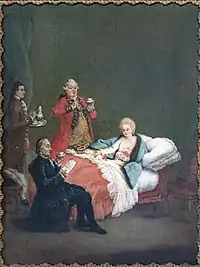
While Columbus had taken cocoa beans with him back to Spain,[20] chocolate made no impact until Spanish friars introduced it to the Spanish court.[13] After the Spanish conquest of the Aztecs, chocolate was imported to Europe. There, it quickly became a court favorite. It was still served as a beverage, but the Spanish added sugar, as well as honey (the original sweetener used by the Aztecs for chocolate), to counteract the natural bitterness.[16] Vanilla, another indigenous American introduction, was also a popular additive, with pepper and other spices sometimes used to give the illusion of a more potent vanilla flavor. Unfortunately, these spices tended to unsettle the European constitution; the Encyclopédie states, "The pleasant scent and sublime taste it imparts to chocolate have made it highly recommended; but a long experience having shown that it could potentially upset one's stomach", which is why chocolate without vanilla was sometimes referred to as "healthy chocolate".[23] By 1602, chocolate had made its way from Spain to Austria.[24] By 1662, Pope Alexander VII had declared that religious fasts were not broken by consuming chocolate drinks. Within about a hundred years, chocolate established a foothold throughout Europe.[13]

The new craze for chocolate brought with it a thriving slave market, as between the early 1600s and late 1800s, the laborious and slow processing of the cocoa bean was manual.[13] Cocoa plantations spread, as the English, Dutch, and French colonized and planted. With the depletion of Mesoamerican workers, largely to disease, cocoa production was often the work of poor wage laborers and African slaves. Wind-powered and horse-drawn mills were used to speed production, augmenting human labor. Heating the working areas of the table-mill, an innovation that emerged in France in 1732, also assisted in extraction.[25]
In 1729, the first water-powered machinery to ground cocoa beans was developed by Charles Churchman and his son Walter in Bristol, England.[26] In 1761, Joseph Fry and his partner John Vaughan bought Churchman's premises, founding Fry's.[26] The same year, Fry and Vaughan also acquired their own patent for a water-powered machine that could grind the cocoa beans to a fine powder and thus produce a superior cocoa drink.[27] In 1795, chocolate production entered the Industrial era when Fry's, under the founder's son Joseph Storrs Fry, used a Watt steam engine to ground cocoa beans.[26] The Baker Chocolate Company, which makes Baker's Chocolate, is the oldest producer of chocolate in the United States. Founded by Dr. James Baker and John Hannon in Boston in 1765, the business is still in operation.[28][29]
Solid chocolate
Despite the drink remaining the traditional form of consumption for a long time, solid chocolate was increasingly consumed since the 18th century.[30][31] Tablets, facilitating the consumption of chocolate under its solid form, have been produced since the early 19th century. Cailler (1819)[32] and Menier (1836)[33] are early examples. In 1830, chocolate is paired with hazelnuts, an innovation due to Kohler.[34]

Meanwhile, new processes that sped the production of chocolate emerged early in the Industrial Revolution. In 1815, Dutch chemist Coenraad van Houten introduced alkaline salts to chocolate, which reduced its bitterness.[13] A few years thereafter, in 1828, he created a press to remove about half the natural fat (cocoa butter) from chocolate liquor, which made chocolate both cheaper to produce and more consistent in quality. This innovation introduced the modern era of chocolate, allowing the mass-production of both pure cocoa butter and cocoa powder.[20]
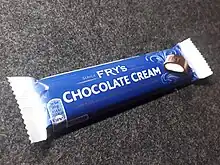
Known as "Dutch cocoa", this machine-pressed chocolate was instrumental in the transformation of chocolate to its solid form when, in 1847, English chocolatier Joseph Fry discovered a way to make chocolate more easily moldable when he mixed the ingredients of cocoa powder and sugar with melted cocoa butter.[16][26] Subsequently, in 1866 his chocolate factory, Fry's, launched the first mass-produced chocolate bar, Fry's Chocolate Cream, and they became very popular.[35] Milk had sometimes been used as an addition to chocolate beverages since the mid-17th century, but in 1875 Swiss chocolatier Daniel Peter invented milk chocolate by mixing a powdered milk developed by Henri Nestlé with the liquor.[13][20] In 1879, the texture and taste of chocolate was further improved when Rudolphe Lindt invented the conching machine.[36]
Besides Nestlé, several notable chocolate companies had their start in the late 19th and early 20th centuries. Rowntree's of York set up and began producing chocolate in 1862, after buying out the Tuke family business. Cadbury of Birmingham was manufacturing boxed chocolates in England by 1868.[13] Manufacturing their first Easter egg in 1875, Cadbury created the modern chocolate Easter egg after developing a pure cocoa butter that could easily be molded into smooth shapes.[37] In 1893, Milton S. Hershey purchased chocolate processing equipment at the World's Columbian Exposition in Chicago, and soon began the career of Hershey's chocolates with chocolate-coated caramels.
Etymology
.png.webp)
Cocoa, pronounced by the Olmecs as kakawa,[1] dates to 1000 BC or earlier.[1] The word "chocolate" entered the English language from Spanish in about 1600.[38] The word entered Spanish from the word chocolātl in Nahuatl, the language of the Aztecs. The origin of the Nahuatl word is uncertain, as it does not appear in any early Nahuatl source, where the word for chocolate drink is cacahuatl, "cocoa water". It is possible that the Spaniards coined the word (perhaps in order to avoid caca, a vulgar Spanish word for "faeces") by combining the Yucatec Mayan word chocol, "hot", with the Nahuatl word atl, "water".[39] A widely cited proposal is that the derives from unattested xocolatl meaning "bitter drink" is unsupported; the change from x- to ch- is unexplained, as is the -l-. Another proposed etymology derives it from the word chicolatl, meaning "beaten drink", which may derive from the word for the frothing stick, chicoli.[40] Other scholars reject all these proposals, considering the origin of first element of the name to be unknown.[41] The term "chocolatier", for a chocolate confection maker, is attested from 1888.[42]
Types
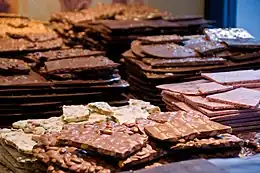
Several types of chocolate can be distinguished. Pure, unsweetened chocolate, often called "baking chocolate", contains primarily cocoa solids and cocoa butter in varying proportions. Much of the chocolate consumed today is in the form of sweet chocolate, which combines chocolate with sugar.
Eating chocolate
The traditional types of chocolate are dark, milk and white. All of them contain cocoa butter, which is the ingredient defining the physical properties of chocolate (consistency and melting temperature). Plain (or dark) chocolate, as it name suggests, is a form of chocolate that is similar to pure cocoa liquor, although is usually made with a slightly higher proportion of cocoa butter.[43] It is simply defined by its cocoa percentage. In milk chocolate, the non-fat cocoa solids are partly or mostly replaced by milk solids.[44] In white chocolate, they are all replaced by milk solids, hence its ivory color.[45]
Other forms of eating chocolate exist, these include raw chocolate (made with unroasted beans) and ruby chocolate. An additional popular form of eating chocolate, gianduja, is made by incorporating nut paste (typically hazelnut) to the chocolate paste.[46]
Other types
Other types of chocolate are used in baking and confectionery. These include baking chocolate (often unsweetened), couverture chocolate (used for coating), compound chocolate (a lower-cost alternative) and modeling chocolate. Modeling chocolate is a chocolate paste made by melting chocolate and combining it with corn syrup, glucose syrup, or golden syrup.[47]
Production
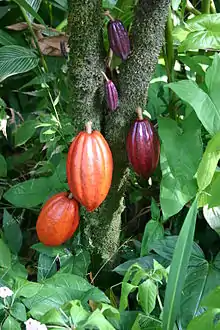
Roughly two-thirds of the entire world's cocoa is produced in West Africa, with 43% sourced from Côte d'Ivoire,[48] where, as of 2007, child labor is a common practice to obtain the product.[49][50] According to the World Cocoa Foundation, in 2007 some 50 million people around the world depended on cocoa as a source of livelihood.[51] As of 2007 in the UK, most chocolatiers purchase their chocolate from them, to melt, mold and package to their own design.[52] According to the WCF's 2012 report, the Ivory Coast is the largest producer of cocoa in the world.[53] The two main jobs associated with creating chocolate candy are chocolate makers and chocolatiers. Chocolate makers use harvested cocoa beans and other ingredients to produce couverture chocolate (covering). Chocolatiers use the finished couverture to make chocolate candies (bars, truffles, etc.).[54]
Production costs can be decreased by reducing cocoa solids content or by substituting cocoa butter with another fat. Cocoa growers object to allowing the resulting food to be called "chocolate", due to the risk of lower demand for their crops.[51]
Genome
The sequencing in 2010 of the genome of the cacao tree may allow yields to be improved.[55] Due to concerns about global warming effects on lowland climate in the narrow band of latitudes where cocoa is grown (20 degrees north and south of the equator), the commercial company Mars, Incorporated and the University of California, Berkeley, are conducting genomic research in 2017–18 to improve the survivability of cacao plants in hot climates.[56]
Cacao varieties
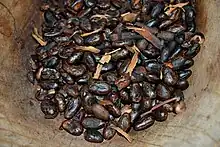
Chocolate is made from cocoa beans, the dried and fermented seeds of the cacao tree (Theobroma cacao), a small, 4–8 m tall (15–26 ft tall) evergreen tree native to the deep tropical region of the Americas. Recent genetic studies suggest the most common genotype of the plant originated in the Amazon basin and was gradually transported by humans throughout South and Central America. Early forms of another genotype have also been found in what is now Venezuela. The scientific name, Theobroma, means "food of the gods".[57] The fruit, called a cocoa pod, is ovoid, 15–30 cm (6–12 in) long and 8–10 cm (3–4 in) wide, ripening yellow to orange, and weighing about 500 g (1.1 lb) when ripe.
Cacao trees are small, understory trees that need rich, well-drained soils. They naturally grow within 20° of either side of the equator because they need about 2000 mm of rainfall a year, and temperatures in the range of 21 to 32 °C (70 to 90 °F). Cacao trees cannot tolerate a temperature lower than 15 °C (59 °F).[58]
The three main varieties of cocoa beans used in chocolate are criollo, forastero, and trinitario.
Processing
Cocoa pods are harvested by cutting them from the tree using a machete, or by knocking them off the tree using a stick. It is important to harvest the pods when they are fully ripe, because if the pod is unripe, the beans will have a low cocoa butter content, or low sugar content, reducing the ultimate flavor.
Microbial fermentation

The beans (which are sterile within their pods) and their surrounding pulp are removed from the pods and placed in piles or bins to ferment. Micro-organisms, present naturally in the environment, ferment the pectin-containing material. Yeasts produce ethanol, lactic acid bacteria produce lactic acid, and acetic acid bacteria produce acetic acid. In some cocoa-producing regions an association between filamentous fungi and bacteria (called "cocobiota") acts to produce metabolites beneficial to human health when consumed.[59] The fermentation process, which takes up to seven days, also produces several flavor precursors, that eventually provide the chocolate taste.[60]
After fermentation, the beans must be dried to prevent mold growth. Climate and weather permitting, this is done by spreading the beans out in the sun from five to seven days.[61] In some growing regions (for example, Tobago), the dried beans are then polished for sale by "dancing the cocoa": spreading the beans onto a floor, adding oil or water, and shuffling the beans against each other using bare feet.[62]
The dried beans are then transported to a chocolate manufacturing facility. The beans are cleaned (removing twigs, stones, and other debris), roasted, and graded. Next, the shell of each bean is removed to extract the nib. The nibs are ground and liquefied, resulting in pure chocolate liquor.[63] The liquor can be further processed into cocoa solids and cocoa butter.[64]
Moist incubation
The beans are dried without fermentation. The nibs are removed and hydrated in an acidic solution. Then they are heated for 72 hours and dried again. Gas chromatography/mass spectrometry showed that the incubated chocolate had higher levels of Strecker aldehydes, and lower levels of pyrazines.[65][66]
Blending
Chocolate liquor is blended with the cocoa butter in varying quantities to make different types of chocolate or couverture. The basic blends of ingredients for the various types of chocolate (in order of highest quantity of cocoa liquor first), are:
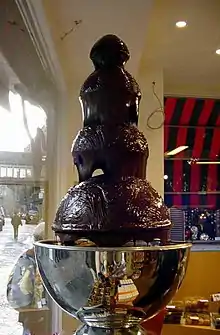
- Dark chocolate: sugar, cocoa butter, cocoa liquor, and (sometimes) vanilla
- Milk chocolate: sugar, cocoa butter, cocoa liquor, milk or milk powder, and vanilla
- White chocolate: sugar, cocoa butter, milk or milk powder, and vanilla
Usually, an emulsifying agent, such as soy lecithin, is added, though a few manufacturers prefer to exclude this ingredient for purity reasons and to remain GMO-free, sometimes at the cost of a perfectly smooth texture. Some manufacturers are now using PGPR, an artificial emulsifier derived from castor oil that allows them to reduce the amount of cocoa butter while maintaining the same mouthfeel.
The texture is also heavily influenced by processing, specifically conching (see below). The more expensive chocolate tends to be processed longer and thus has a smoother texture and mouthfeel, regardless of whether emulsifying agents are added.
Different manufacturers develop their own "signature" blends based on the above formulas, but varying proportions of the different constituents are used. The finest, plain dark chocolate couverture contains at least 70% cocoa (both solids and butter), whereas milk chocolate usually contains up to 50%. High-quality white chocolate couverture contains only about 35% cocoa butter.
Producers of high-quality, small-batch chocolate argue that mass production produces bad-quality chocolate.[67] Some mass-produced chocolate contains much less cocoa (as low as 7% in many cases), and fats other than cocoa butter. Vegetable oils and artificial vanilla flavor are often used in cheaper chocolate to mask poorly fermented and/or roasted beans.[67]
In 2007, the Chocolate Manufacturers Association in the United States, whose members include Hershey, Nestlé, and Archer Daniels Midland, lobbied the Food and Drug Administration (FDA) to change the legal definition of chocolate to let them substitute partially hydrogenated vegetable oils for cocoa butter, in addition to using artificial sweeteners and milk substitutes.[68] Currently, the FDA does not allow a product to be referred to as "chocolate" if the product contains any of these ingredients.[69][70]
In the EU a product can be sold as chocolate if it contains up to 5% vegetable oil, and must be labeled as "family milk chocolate" rather than "milk chocolate" if it contains 20% milk.[71]
According to Canadian Food and Drug Regulations,[72] a "chocolate product" is a food product that is sourced from at least one "cocoa product" and contains at least one of the following: "chocolate, bittersweet chocolate, semi-sweet chocolate, dark chocolate, sweet chocolate, milk chocolate, or white chocolate". A "cocoa product" is defined as a food product that is sourced from cocoa beans and contains "cocoa nibs, cocoa liquor, cocoa mass, unsweetened chocolate, bitter chocolate, chocolate liquor, cocoa, low-fat cocoa, cocoa powder, or low-fat cocoa powder".
Conching

The penultimate process is called conching. A conche is a container filled with metal beads, which act as grinders. The refined and blended chocolate mass is kept in a liquid state by frictional heat. Chocolate before conching has an uneven and gritty texture. The conching process produces cocoa and sugar particles smaller than the tongue can detect (typically around 20 μm) and reduces rough edges, hence the smooth feel in the mouth. The length of the conching process determines the final smoothness and quality of the chocolate. High-quality chocolate is conched for about 72 hours, and lesser grades about four to six hours. After the process is complete, the chocolate mass is stored in tanks heated to about 45 to 50 °C (113 to 122 °F) until final processing.[73]
Tempering
The final process is called tempering. Uncontrolled crystallization of cocoa butter typically results in crystals of varying size, some or all large enough to be seen with the naked eye. This causes the surface of the chocolate to appear mottled and matte, and causes the chocolate to crumble rather than snap when broken.[74][75] The uniform sheen and crisp bite of properly processed chocolate are the results of consistently small cocoa butter crystals produced by the tempering process.
The fats in cocoa butter can crystallize in six different forms (polymorphous crystallization).[74][76] The primary purpose of tempering is to assure that only the best form, Type V, is present. The six different crystal forms have different properties.
| Crystal | Melting temp. | Notes |
|---|---|---|
| I | 17 °C (63 °F) | Soft, crumbly, melts too easily |
| II | 21 °C (70 °F) | Soft, crumbly, melts too easily |
| III | 26 °C (79 °F) | Firm, poor snap, melts too easily |
| IV | 28 °C (82 °F) | Firm, good snap, melts too easily |
| V | 34 °C (93 °F) | Glossy, firm, best snap, melts near body temperature (37 °C) |
| VI | 36 °C (97 °F) | Hard, takes weeks to form |
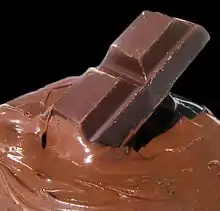
As a solid piece of chocolate, the cocoa butter fat particles are in a crystalline rigid structure that gives the chocolate its solid appearance. Once heated, the crystals of the polymorphic cocoa butter can break apart from the rigid structure and allow the chocolate to obtain a more fluid consistency as the temperature increases – the melting process. When the heat is removed, the cocoa butter crystals become rigid again and come closer together, allowing the chocolate to solidify.[77]
The temperature in which the crystals obtain enough energy to break apart from their rigid conformation would depend on the milk fat content in the chocolate and the shape of the fat molecules, as well as the form of the cocoa butterfat. Chocolate with a higher fat content will melt at a lower temperature.[78]
Making chocolate considered "good" is about forming as many type V crystals as possible. This provides the best appearance and texture and creates the most stable crystals, so the texture and appearance will not degrade over time. To accomplish this, the temperature is carefully manipulated during the crystallization.
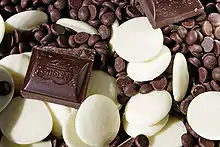
Generally, the chocolate is first heated to 45 °C (113 °F) to melt all six forms of crystals.[74][76] Next, the chocolate is cooled to about 27 °C (81 °F), which will allow crystal types IV and V to form. At this temperature, the chocolate is agitated to create many small crystal "seeds" which will serve as nuclei to create small crystals in the chocolate. The chocolate is then heated to about 31 °C (88 °F) to eliminate any type IV crystals, leaving just type V. After this point, any excessive heating of the chocolate will destroy the temper and this process will have to be repeated. Other methods of chocolate tempering are used as well. The most common variant is introducing already tempered, solid "seed" chocolate. The temper of chocolate can be measured with a chocolate temper meter to ensure accuracy and consistency. A sample cup is filled with the chocolate and placed in the unit which then displays or prints the results.
Two classic ways of manually tempering chocolate are:
- Working the molten chocolate on a heat-absorbing surface, such as a stone slab, until thickening indicates the presence of sufficient crystal "seeds"; the chocolate is then gently warmed to working temperature.
- Stirring solid chocolate into molten chocolate to "inoculate" the liquid chocolate with crystals (this method uses the already formed crystals of the solid chocolate to "seed" the molten chocolate).
Chocolate tempering machines (or temperers) with computer controls can be used for producing consistently tempered chocolate. In particular, continuous tempering machines are used in large volume applications. Various methods and apparatuses for continuous flow tempering. In general, molten chocolate coming in at 40–50 °C is cooled in heat exchangers to crystallization temperates of about 26–30 °C, passed through a tempering column consisting of spinning plates to induce shear, then warmed slightly to re-melt undesirable crystal formations.
Shaping
Chocolate is molded in different shapes for different uses:[79]
- Chocolate bars (tablets) are rectangular blocks of chocolate meant to be broken down to cubes (or other predefined shapes), which can then be used for consumption, cooking and baking. The term is also used for combination bars, which are a type of candy bars
- Chocolate chips are small pieces of chocolate, usually drop-like, which are meant for decoration and baking
- Pistoles, callets and fèves are small, coin-like or bean-like pieces of chocolate meant for baking and patisserie applications (also see Pistole (coin) and Fève (trinket))
- Chocolate blocks are large, cuboid chunks of chocolate meant for professional use and further processing
- Other, more specialized shapes for chocolate include sticks, curls and hollow semi-spheres
Storage

Chocolate is very sensitive to temperature and humidity. Ideal storage temperatures are between 15 and 17 °C (59 and 63 °F), with a relative humidity of less than 50%. If refrigerated or frozen without containment, chocolate can absorb enough moisture to cause a whitish discoloration, the result of fat or sugar crystals rising to the surface. Various types of "blooming" effects can occur if chocolate is stored or served improperly.[80]
Chocolate bloom is caused by storage temperature fluctuating or exceeding 24 °C (75 °F), while sugar bloom is caused by temperature below 15 °C (59 °F) or excess humidity. To distinguish between different types of bloom, one can rub the surface of the chocolate lightly, and if the bloom disappears, it is fat bloom. Moving chocolate between temperature extremes, can result in an oily texture. Although visually unappealing, chocolate suffering from bloom is safe for consumption and taste unaffected.[81][82][83] Bloom can be reversed by retempering the chocolate or using it for any use that requires melting the chocolate.[84]
Chocolate is generally stored away from other foods, as it can absorb different aromas. Ideally, chocolates are packed or wrapped, and placed in proper storage with the correct humidity and temperature. Additionally, chocolate is frequently stored in a dark place or protected from light by wrapping paper. The glossy shine, snap, aroma, texture, and taste of the chocolate can show the quality and if it was stored well.[85]
| Nutritional value per 100 g (3.5 oz) | |
|---|---|
| Energy | 2,240 kJ (540 kcal) |
59.4 | |
| Sugars | 51.5 g |
| Dietary fiber | 3.4 g |
29.7 | |
7.6 g | |
| Vitamins | Quantity %DV† |
| Vitamin A | 195 IU |
| Thiamine (B1) | 9% 0.1 mg |
| Riboflavin (B2) | 25% 0.3 mg |
| Niacin (B3) | 3% 0.4 mg |
| Pantothenic acid (B5) | 10% 0.5 mg |
| Vitamin B6 | 0% 0.0 mg |
| Folate (B9) | 3% 11 μg |
| Vitamin B12 | 29% 0.7 μg |
| Choline | 9% 46.1 mg |
| Vitamin C | 0% 0 mg |
| Vitamin E | 3% 0.5 mg |
| Vitamin K | 5% 5.7 μg |
| Minerals | Quantity %DV† |
| Calcium | 19% 189 mg |
| Iron | 18% 2.4 mg |
| Magnesium | 18% 63 mg |
| Manganese | 24% 0.5 mg |
| Phosphorus | 30% 208 mg |
| Potassium | 8% 372 mg |
| Selenium | 6% 4.5 μg |
| Sodium | 5% 79 mg |
| Zinc | 24% 2.3 mg |
| Other constituents | Quantity |
| Water | 1.5 g |
| Caffeine | 20 mg |
| Cholesterol | 23 mg |
| Theobromine | 205 mg |
| |
| †Percentages are roughly approximated using US recommendations for adults. Source: USDA FoodData Central | |
Nutrition
One hundred grams of milk chocolate supplies 540 calories. It is 59% carbohydrates (52% as sugar and 3% as dietary fiber), 30% fat and 8% protein (table). Approximately 65% of the fat in milk chocolate is saturated, mainly palmitic acid and stearic acid, while the predominant unsaturated fat is oleic acid (table).
100-grams of milk chocolate is an excellent source (over 19% of the Daily Value, DV) of riboflavin, vitamin B12 and the dietary minerals, manganese, phosphorus and zinc. Chocolate is a good source (10–19% DV) of calcium, magnesium and iron.
.jpg.webp)
Health effects
Phytochemicals
Chocolate contains polyphenols, especially flavan-3-ols (catechins) and smaller amounts of other flavonoids.[86][87] It also contains alkaloids, such as theobromine, phenethylamine, and caffeine.[88] which are under study for their potential effects in the body.[89]
Lead
Although research suggests that even low levels of lead in the body may be harmful to children,[90][91] it is unlikely that chocolate consumption in small amounts causes lead poisoning. Some studies have shown that lead may bind to cocoa shells, and contamination may occur during the manufacturing process.[92] One study showed the mean lead level in milk chocolate candy bars was 0.027 µg lead per gram of candy;[92] another study found that some chocolate purchased at U.S. supermarkets contained up to 0.965 µg per gram, close to the international (voluntary) standard limit for lead in cocoa powder or beans, which is 1 µg of lead per gram.[93] In 2006, the U.S. FDA lowered by one-fifth the amount of lead permissible in candy, but compliance is only voluntary.[94] Studies concluded that "children, who are big consumers of chocolates, may be at risk of exceeding the daily limit of lead; whereas one 10 g cube of dark chocolate may contain as much as 20% of the daily lead oral limit. "Moreover chocolate may not be the only source of lead in their nutrition"[95] and "chocolate might be a significant source of cadmium and lead ingestion, particularly for children."[96] According to a 2005 study, the average lead concentration of cocoa beans is ≤ 0.5 ng/g, which is one of the lowest reported values for a natural food.[92] However, during cultivation and production, chocolate may absorb lead from the environment (such as in atmospheric emissions of leaded gasoline, which is still being used in Nigeria).[92]
Cadmium
The European Food Safety Authority recommended a tolerable weekly intake for cadmium of 2.5 micrograms per kg of body weight for Europeans, indicating that consuming chocolate products caused exposure of about 4% among all foods eaten.[97][98][99] 1986 California Proposition 65 requires a warning label on chocolate products having more than 4.1 mg of cadmium per daily serving of a single product.[100][101][102]
Caffeine
One tablespoonful (5 grams) of dry unsweetened cocoa powder has 12.1 mg of caffeine[103] and a 25-g single serving of dark chocolate has 22.4 mg of caffeine.[104] Although a single 7 oz. (200 ml) serving of coffee may contain 80–175 mg,[105] studies have shown psychoactive effects in caffeine doses as low as 9 mg, and a dose as low as 12.5 mg was shown to have effects on cognitive performance.[106]
Theobromine and oxalate
Chocolate may be a factor for heartburn in some people because one of its constituents, theobromine, may affect the esophageal sphincter muscle in a way that permits stomach acids to enter the esophagus.[107] Theobromine poisoning is an overdosage reaction to the bitter alkaloid, which happens more frequently in domestic animals than humans. However, daily intake of 50–100 g cocoa (0.8–1.5 g theobromine) by humans has been associated with sweating, trembling and severe headache.
Chocolate and cocoa contain moderate to high amounts of oxalate,[108][109] which may increase the risk of kidney stones.[110]
Non-human animals
In sufficient amounts, the theobromine found in chocolate is toxic to animals such as cats, dogs, horses, parrots, and small rodents because they are unable to metabolise the chemical effectively.[111] If animals are fed chocolate, the theobromine may remain in the circulation for up to 20 hours, possibly causing epileptic seizures, heart attacks, internal bleeding, and eventually death. Medical treatment performed by a veterinarian involves inducing vomiting within two hours of ingestion and administration of benzodiazepines or barbiturates for seizures, antiarrhythmics for heart arrhythmias, and fluid diuresis.
A typical 20-kilogram (44 lb) dog will normally experience great intestinal distress after eating less than 240 grams (8.5 oz) of dark chocolate, but will not necessarily experience bradycardia or tachycardia unless it eats at least a half a kilogram (1.1 lb) of milk chocolate. Dark chocolate has 2 to 5 times more theobromine and thus is more dangerous to dogs. According to the Merck Veterinary Manual, approximately 1.3 grams of baker's chocolate per kilogram of a dog's body weight (0.02 oz/lb) is sufficient to cause symptoms of toxicity. For example, a typical 25-gram (0.88 oz) baker's chocolate bar would be enough to bring about symptoms in a 20-kilogram (44 lb) dog. In the 20th century, there were reports that mulch made from cacao bean shells is dangerous to dogs and livestock.[112][113]
Research
Obesity
Commonly consumed chocolate is high in fat and sugar, which are associated with an increased risk for obesity when chocolate is consumed in excess.[114]
Acne
Overall evidence is insufficient to determine the relationship between chocolate consumption and acne.[115][116] Various studies point not to chocolate, but to the high glycemic nature of certain foods, like sugar, corn syrup, and other simple carbohydrates, as potential causes of acne,[115][116][117][118] along with other possible dietary factors.[115][119]
Addiction
Food, including chocolate, is not typically viewed as addictive.[120] Some people, however, may want or crave chocolate,[120] leading to a self-described term, chocoholic.[120][121]
Mood
By some popular myths, chocolate is considered to be a mood enhancer, such as by increasing sex drive or stimulating cognition, but there is little scientific evidence that such effects are consistent among all chocolate consumers.[122][123] If mood improvement from eating chocolate occurs, there is not enough research to indicate whether it results from the favorable flavor or from the stimulant effects of its constituents, such as caffeine, theobromine, or their parent molecule, methylxanthine.[123] A 2019 review reported that chocolate consumption does not improve depressive mood.[124]
Heart and blood vessels
Reviews support a short-term effect of lowering blood pressure by consuming cocoa products, but there is no evidence of long-term cardiovascular health benefit.[125][126] Chocolate and cocoa are under preliminary research to determine if consumption affects the risk of certain cardiovascular diseases[127] or cognitive abilities.[128]
While daily consumption of cocoa flavanols (minimum dose of 200 mg) appears to benefit platelet and vascular function,[129] there is no good evidence to indicate an effect on heart attacks or strokes.[129][130] Research has also shown that consuming dark chocolate does not substantially affect blood pressure.[131]
Labeling
Some manufacturers provide the percentage of chocolate in a finished chocolate confection as a label quoting percentage of "cocoa" or "cacao". This refers to the combined percentage of both cocoa solids and cocoa butter in the bar, not just the percentage of cocoa solids.[132] The Belgian AMBAO certification mark indicates that no non-cocoa vegetable fats have been used in making the chocolate.[133][134] A long-standing dispute between Britain on the one hand and Belgium and France over British use of vegetable fats in chocolate ended in 2000 with the adoption of new standards which permitted the use of up to five percent vegetable fats in clearly labelled products.[135] This British style of chocolate has sometimes been pejoratively referred to as "vegelate".[135]
Chocolates that are organic[136] or fair trade certified[137] carry labels accordingly.
In the United States, some large chocolate manufacturers lobbied the federal government to permit confections containing cheaper hydrogenated vegetable oil in place of cocoa butter to be sold as "chocolate". In June 2007, in response to consumer concern about the proposal, the FDA reiterated "Cacao fat, as one of the signature characteristics of the product, will remain a principal component of standardized chocolate."[138]
Industry
Chocolate, prevalent throughout the world, is a steadily growing, US$50 billion-a-year worldwide business.[139] Europe accounts for 45% of the world's chocolate revenue,[140] and the US spent $20 billion in 2013.[141] Big Chocolate is the grouping of major international chocolate companies in Europe and the U.S. U.S. companies Mars and Hershey's alone generated $13 billion a year in chocolate sales and account for two-thirds of U.S. production in 2004.[142] Despite the expanding reach of the chocolate industry internationally, cocoa farmers and labourers in the Ivory Coast are often unaware of the uses of the beans; the high cost of chocolate products in the Ivory Coast makes them inaccessible to the majority of the population, who do not know what chocolate tastes like.[143]
Manufacturers

Chocolate manufacturers produce a range of products from chocolate bars to fudge. Large manufacturers of chocolate products include Cadbury (the world's largest confectionery manufacturer), Ferrero, Guylian, The Hershey Company, Lindt & Sprüngli, Mars, Incorporated, Milka, Neuhaus and Suchard.
Guylian is best known for its chocolate sea shells; Cadbury for its Dairy Milk and Creme Egg. The Hershey Company, the largest chocolate manufacturer in North America, produces the Hershey Bar and Hershey's Kisses.[144] Mars Incorporated, a large privately owned U.S. corporation, produces Mars Bar, Milky Way, M&M's, Twix, and Snickers. Lindt is known for its truffle balls and gold foil-wrapped Easter bunnies.
Food conglomerates Nestlé SA and Kraft Foods both have chocolate brands. Nestlé acquired Rowntree's in 1988 and now markets chocolates under their brand, including Smarties (a chocolate candy) and Kit Kat (a chocolate bar); Kraft Foods through its 1990 acquisition of Jacobs Suchard, now owns Milka and Suchard. In February 2010, Kraft also acquired British-based Cadbury;[145] Fry's, Trebor Basset and the fair trade brand Green & Black's also belongs to the group.
Child labor in cocoa harvesting
The widespread use of children in cocoa production is controversial, not only for the concerns about child labor and exploitation, but also because up to 12,000 of the 200,000 children working in the Ivory Coast, the world's biggest producer of cocoa,[146] may be victims of trafficking or slavery.[147] Most attention on this subject has focused on West Africa, which collectively supplies 69 percent of the world's cocoa,[148] and the Ivory Coast in particular, which supplies 35 percent of the world's cocoa.[148] Thirty percent of children under age 15 in sub-Saharan Africa are child laborers, mostly in agricultural activities including cocoa farming.[149] Major chocolate producers, such as Nestlé, buy cocoa at commodities exchanges where Ivorian cocoa is mixed with other cocoa.[150]
In 2009, Salvation Army International Development (SAID) UK stated that 12,000 children have been trafficked on cocoa farms in the Ivory Coast of Africa, where half of the world's chocolate is made.[151] SAID UK states that it is these child slaves who are likely to be working in "harsh and abusive"[152] conditions for the production of chocolate,[151] and an increasing number of health-food[153] and anti-slavery[154] organisations are highlighting and campaigning against the use of trafficking in the chocolate industry.
As of 2017, approximately 2.1 million children in Ghana and Côte d'Ivoire were involved in farming cocoa, carrying heavy loads, clearing forests, and being exposed to pesticides.[5] According to Sona Ebai, the former secretary-general of the Alliance of Cocoa Producing Countries: "I think child labor cannot be just the responsibility of industry to solve. I think it's the proverbial all-hands-on-deck: government, civil society, the private sector. And there, you need leadership."[147] Reported in 2018, a 3-year pilot program – conducted by Nestlé with 26,000 farmers mostly located in Côte d'Ivoire – observed a 51% decrease in the number of children doing hazardous jobs in cocoa farming.[4] The US Department of Labor formed the Child Labor Cocoa Coordinating Group as a public-private partnership with the governments of Ghana and Côte d'Ivoire to address child labor practices in the cocoa industry.[155] The International Cocoa Initiative involving major cocoa manufacturers established the Child Labor Monitoring and Remediation System intended to monitor thousands of farms in Ghana and Côte d'Ivoire for child labor conditions,[4][5] but the program reached less than 20% of the child laborers.[156] Despite these efforts, goals to reduce child labor in West Africa by 70% before 2020 are frustrated by persistent poverty, absence of schools, expansion of cocoa farmland, and increased demand for cocoa.[4][157]
In April 2018, the Cocoa Barometer report stated: "Not a single company or government is anywhere near reaching the sector-wide objective of the elimination of child labor, and not even near their commitments of a 70% reduction of child labor by 2020".[157]
Fair trade
In the 2000s, some chocolate producers began to engage in fair trade initiatives, to address concerns about the marginalization of cocoa laborers in developing countries. Traditionally, Africa and other developing countries received low prices for their exported commodities such as cocoa, which caused poverty to abound. Fairtrade seeks to establish a system of direct trade from developing countries to counteract this unfair system.[158] One solution for fair labor practices is for farmers to become part of an Agricultural cooperative. Cooperatives pay farmers a fair price for their cocoa so farmers have enough money for food, clothes, and school fees.[159] One of the main tenets of fair trade is that farmers receive a fair price, but this does not mean that the larger amount of money paid for fair trade cocoa goes directly to the farmers. The effectiveness of fair trade has been questioned. In a 2014 article, The Economist stated that workers on fair trade farms have a lower standard of living than on similar farms outside the fair trade system.[160]
Usage and consumption
Bars
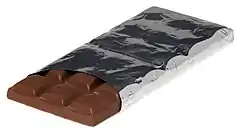
Chocolate is sold in chocolate bars, which come in dark chocolate, milk chocolate and white chocolate varieties. Some bars that are mostly chocolate have other ingredients blended into the chocolate, such as nuts, raisins, or crisped rice. Chocolate is used as an ingredient in a huge variety of bars, which typically contain various confectionary ingredients (e.g., nougat, wafers, caramel, nuts, etc.) which are coated in chocolate.
Coating and filling

Chocolate is used as a flavouring product in many desserts, such as chocolate cakes, chocolate brownies, chocolate mousse and chocolate chip cookies. Numerous types of candy and snacks contain chocolate, either as a filling (e.g., M&M's) or as a coating (e.g., chocolate-coated raisins or chocolate-coated peanuts).
Beverages
Some non-alcoholic beverages contain chocolate, such as chocolate milk, hot chocolate, chocolate milkshakes and tejate. Some alcoholic liqueurs are flavoured with chocolate, such as chocolate liqueur and creme de cacao. Chocolate is a popular flavour of ice cream and pudding, and chocolate sauce is a commonly added as a topping on ice cream sundaes. The caffè mocha is an espresso beverage containing chocolate.
Popular culture
Religious and cultural links

Chocolate is associated with festivals such as Easter, when moulded chocolate rabbits and eggs are traditionally given in Christian communities, and Hanukkah, when chocolate coins are given in Jewish communities. Chocolate hearts and chocolate in heart-shaped boxes are popular on Valentine's Day and are often presented along with flowers and a greeting card. In 1868, Cadbury created a decorated box of chocolates in the shape of a heart for Valentine's Day.[35][161] Boxes of filled chocolates quickly became associated with the holiday.[35] Chocolate is an acceptable gift on other holidays and on occasions such as birthdays.
Many confectioners make holiday-specific chocolate candies. Chocolate Easter eggs or rabbits and Santa Claus figures are two examples. Such confections can be solid, hollow, or filled with sweets or fondant.
Books and film
Chocolate has been the center of several successful book and film adaptations. In 1964, Roald Dahl published a children's novel titled Charlie and the Chocolate Factory. The novel centers on a poor boy named Charlie Bucket who takes a tour through the greatest chocolate factory in the world, owned by the eccentric Willy Wonka.[162] Two film adaptations of the novel were produced: Willy Wonka & the Chocolate Factory (1971) and Charlie and the Chocolate Factory (2005). A third adaptation, an origin prequel film titled Wonka, is scheduled for release in 2023.[163]
Like Water for Chocolate a 1989 love story by novelist Laura Esquivel, was adapted to film in 1992. Chocolat, a 1999 novel by Joanne Harris, was adapted for film in Chocolat which was released a year later.[164]
See also
- Candida krusei
- Candy making
- Children in cocoa production
- Chocolataire
- Chocolate almonds
- Chocolate chip
- Chocoholic
- Cuestión moral: si el chocolate quebranta el ayuno eclesiástico
- List of chocolate-covered foods
- List of chocolate beverages
- List of chocolate companies
- Theobroma cacao, the cocoa/chocolate plant
- United States military chocolate
- Types of chocolate
References
- Powis, Terry G.; Cyphers, Ann; Gaikwad, Nilesh W.; Grivetti, Louis; Cheong, Kong (24 May 2011). "Cacao use and the San Lorenzo Olmec". Proceedings of the National Academy of Sciences. 108 (21): 8595–8600. Bibcode:2011PNAS..108.8595P. doi:10.1073/pnas.1100620108. ISSN 0027-8424. PMC 3102397. PMID 21555564.
- "Consumían olmecas chocolate hace 3000 años". El Universal. Mexico City. 29 July 2008. Archived from the original on 16 October 2013. Retrieved 20 January 2018.
- "Chocolate: A Mesoamerican Luxury 1200–1521 – Obtaining Cacao". Field Museum. Retrieved 23 November 2011.
- Oliver Balch (20 June 2018). "Child labour: the true cost of chocolate production". Raconteur. Archived from the original on 27 July 2020. Retrieved 7 January 2019.
- Kieran Guilbert (12 June 2017). "Falling cocoa prices threaten child labor spike in Ghana, Ivory Coast". Reuters. Retrieved 7 January 2019.
- Terry G. Powis; W. Jeffrey Hurst; María del Carmen Rodríguez; Ponciano Ortíz C.; Michael Blake; David Cheetham; Michael D. Coe; John G. Hodgson (December 2007). "Oldest chocolate in the New World". Antiquity. 81 (314). ISSN 0003-598X. Archived from the original on 28 June 2011. Retrieved 15 February 2011.
- Watson, Traci (22 January 2013). "Earliest Evidence of Chocolate in North America". Science. Archived from the original on 6 March 2014. Retrieved 3 March 2014.
- "New Chemical Analyses Take Confirmation Back 500 Years and Reveal that the Impetus for Cacao Cultivation was an Alcoholic Beverage". Penn Museum. 2007. Archived from the original on 2 December 2007. Retrieved 13 November 2007.
- Burleigh, Robert (2002). Chocolate: Riches from the Rainforest. Harry N. Abrams, Ins., Publishers. ISBN 978-0-8109-5734-3.
- "Chocolate: A Mesoamerican Luxury 250–900 C.E. (A.D.) – Using Chocolate". Field Museum. Retrieved 23 November 2011.
- "Chocolate: A Mesoamerican Luxury 250–900 C.E. (A.D.) – Obtaining Cacao". Field Museum. Retrieved 2 June 2008.
- "Chocolate: A Mesoamerican Luxury 250–900 C.E. (A.D.) – Making Chocolate". Field Museum. Retrieved 2 June 2008.
- "History of Chocolate". Field Museum. Retrieved 3 March 2014.
- "Aztecs and Cacao: the bittersweet past of chocolate". The Daily Telegraph. 15 September 2009. Archived from the original on 18 April 2014. Retrieved 8 March 2014.
- Peniche Rivero, Piedad (1990). "When cocoa was used as currency – pre-Columbian America – The Fortunes of Money". UNESCO Courier. Archived from the original on 27 May 2012. Retrieved 26 June 2008.
- Bensen, Amanda (1 March 2008). "A Brief History of Chocolate". Smithsonian Magazine. Retrieved 3 March 2014.
- Buford, Bill (29 October 2007). "Notes of a Gastronome: Extreme Chocolate". The New Yorker. Archived from the original on 16 June 2008. Retrieved 17 May 2008.
- Coe & Coe (2013), p. 46.
- Chinchilla Mazariegos (2017), p. 361.
- Spadaccini, Jim. "The Sweet Lure of Chocolate". Exploratorium. Archived from the original on 14 March 2014. Retrieved 3 March 2014.
- Solís y Ribadeneyra, Antonio de (1685). "Book III Chapter XV". The History of the Conquest of Mexico by the Spaniards, done into English by Thomas Townsend. Translated by Thomas Townsend. London. pp. 336–38.
- de Acosta, José. "Historia Natural y Moral de las Indias". Pueblos Originarios. Retrieved 24 May 2021.
- Diderot, Denis. "Chocolate". Archived 1 November 2022 at the Wayback Machine in The Encyclopedia of Diderot & d'Alembert Collaborative Translation Project. Translated by Colleen Oberc, Samantha Schaeffer, and Courtney Wilder. Ann Arbor: University of Michigan Library, 2015. Trans. of "Chocolat", Encyclopédie ou Dictionnaire raisonné des sciences, des arts et des métiers, vol. 3. Paris, 1753".
- Szogyi, Alex (1997). Chocolate: Food of the Gods. Greenwood Publishing Group. p. 199. ISBN 978-0-313-30506-1. Archived from the original on 5 February 2016.
- Wilson, Philip K.; Hurst, W. Jeffrey, eds. (2015). Chocolate and Health. Royal Society of Chemistry. p. 219. doi:10.1039/9781782622802. ISBN 978-1-84973-912-2.
- Swinnen, Johan F. M.; Squicciarini, Mara P. (2016). The Economics of Chocolate. Oxford University Press. p. 17.
- Latimer, John (1893). The Annals of Bristol in the Eighteenth Century. p. 177.
- "Boston's chocolate history". Boston Globe. 27 July 2013.
- "Where did the first chocolate factory in the U.S. open?". Travel Trivia. 25 November 2019.
- Coe, Sophie D. (2015) [1994]. America's First Cuisines. University of Texas Press. pp. 56–57. ISBN 9781477309711.
Most sixteenth-, seventeenth-, and eighteenth-century cacao was for drinking, but its consumption in solid form was not unheard of. To make a drink out of processed cacao beans they must be ground, and then, unless they are immediately made into a drink, the mass congeals. [...] A tablet of this nature could be dissolved in hot water to make the breakfast chocolate, but it could also be nibbled. [...] With the addition of sugar this began the production of what are called modern chocolates. Many people take it to mean that solid chocolate was not eaten before Van Houten's time, but as the preceding paragraph has shown, this is not so.
- Davidson, Alan (2014). The Oxford Companion to Food. OUP Oxford. p. 183. ISBN 978-0-19-104072-6.
Already by the end of the 18th century there had been a perceptible increase in the amount of chocolate being eaten, in slabs and pastilles...
- Barel, Michel (2021). Du cacao au chocolat: L'épopée d'une gourmandise. Éditions Quæ. p. 102. ISBN 9782759233793.
Le premier est François-Louis Cailler, l'inventeur de la tablette de chocolat telle que nous la connaissons aujourd'hui.
[The first is François-Louis Cailler, the inventor of the chocolate tablet as we know it today.] - Maraval, Pierre (2019). Madame Piffaut: La vie mystérieuse de la reine des escrocs. Max Milo. ISBN 9782315009336.
Au xixe siècle, des fabriques de chocolat ouvrirent dans divers pays ; les premières se nommaient Cailler, Suchard, Cadbury, Van Houten. Mais c'est un Français, Antoine Brutus Menier, qui révolutionna le commerce du chocolat en inventant en 1836 la tablette, composée de barres semi-cylindriques enveloppées dans du papier.
[In the nineteenth century, chocolate factories opened in various countries; the first were named Cailler, Suchard, Cadbury, Van Houten. But it was a Frenchman, Antoine Brutus Menier, who revolutionized the chocolate trade by inventing the tablet in 1836, made up of semi-cylindrical bars wrapped in paper.] - Hermé, Pierre (2019). Le Larousse du chocolat. Editions Larousse. p. 44. ISBN 9782035981820.
Les noisettes furent les premiers fruits à être ajoutés dans le chocolat solide, une innovation suisse due à Kohler en 1830.
[Hazelnuts were the first fruits to be added to solid chocolate, a Swiss innovation due to Kohler in 1830.] - Mintz, Sidney (2015). The Oxford Companion to Sugar and Sweets. Oxford University Press. p. 157.
- Klein, Christopher (14 February 2014). "The Sweet History of Chocolate". History. Archived from the original on 8 March 2014. Retrieved 3 March 2014.
- "Amazing archive images show how Cadbury cracked Easter egg market". Birmingham Mail. Retrieved 21 May 2019.
- "Chocolate". The American Heritage Dictionary. Archived from the original on 17 May 2008. Retrieved 9 May 2009.
- Coe & Coe (2013), pp. 121–123.
- Dakin, Karen; Wichmann, Søren (2000). "Cacao and Chocolate: A Uto-Aztecan perspective". Ancient Mesoamerica. 11 (1): 55–75. doi:10.1017/S0956536100111058. S2CID 162616811. Retrieved 10 January 2018.
- Kaufman, Terrence; Justeson, John (2007). "The history of the word for Cacao in ancient Mesoamerica". Ancient Mesoamerica. 18 (2): 193–237. doi:10.1017/S0956536107000211. S2CID 163097273. Retrieved 18 June 2021.
- Harper, Douglas. "Chocolate". Online Etymology Dictionary.
- Afoakwa, Emmanuel Ohene (2011). "7.3 Materials and Methods". Chocolate Science and Technology. John Wiley & Sons. ISBN 9781444357332.
Recipes used for the formulation of the dark chocolate
- Spyropoulos, Fotis (2019). Handbook of Food Structure Development. Royal Society of Chemistry. p. 136. ISBN 9781788012164.
- Beckett, Steve T. (2017). Beckett's Industrial Chocolate Manufacture and Use. John Wiley & Sons. p. 498. ISBN 9781118780145.
Typical recipes for white bar chocolate
- Medrich, Alice (2015). Pure Dessert: True Flavors, Inspiring Ingredients, and Simple Recipes. Artisan Books. p. 157. ISBN 9781579656850.
gianduja resembles a bar of chocolate. It is softer on the tooth than a plain chocolate bar (because of the oil from the hazelnuts)
- Peters, Colette (6 December 2013). "Modeling Chocolate". Food & Wine. Retrieved 28 May 2015.
- Ariyoshi, Rita (2007). "The Rarest Chocolate in the World – Surprise: It's made in Hawai'i". Spirit of Aloha. Archived from the original on 18 October 2007. Retrieved 2 May 2007.
- Hawksley, Humphrey (13 June 2002). "Meeting the 'chocolate slaves'". BBC News. Archived from the original on 30 September 2009. Retrieved 22 January 2010.
- McKenzie, David and Swails, Brent (19 January 2012) Slavery in Cocoa fields: a horrible "normal" Archived 16 March 2016 at the Wayback Machine. CNN.
- Bridges, Andrew (7 August 2007). "Sides square off in chocolate fight". Pantagraph. Archived from the original on 12 April 2009. Retrieved 17 May 2008.
- Dillon, Sheila (23 December 2007). "The Food Programme" (RealAudio). BBC Radio 4. Archived from the original on 9 November 2014.
- "Cocoa Market Update (2012)" (PDF). World Cocoa Foundation. Archived from the original (PDF) on 6 June 2014. Retrieved 17 August 2014.
- "What's Noka Worth? An investigation in high-priced chocolate". Dallas Food. 9 December 2006. Archived from the original on 13 June 2007. Retrieved 31 December 2006.
- "Chocolate industry avoids collapse as genome published". BBC. 14 November 2010. Archived from the original on 15 November 2010. Retrieved 15 November 2010.
- Brodwin, Erin (31 December 2017). "Chocolate is on track to go extinct in 40 years". Business Insider. Business Insider, Inc. Retrieved 31 January 2018.
- "Cacao". Botanica.com. 1995–2008. Archived from the original on 14 May 2008. Retrieved 27 June 2008.
- "All About Chocolate: The Cacao Tree". Xocoatl. Archived from the original on 19 December 2007. Retrieved 20 December 2007.
- Guzmán-Alvarez, Romel; G. Márquez-Ramos, José (2021). Laranjo, Marta (ed.). Fermentation – Processes, Benefits and Risks. Évora, Portugal: University of Évora. p. 128. ISBN 978-1-83968-816-4.
- Schwan, R.; Wheals, A. (2004). "The Microbiology of Cocoa Fermentation and its Role in Chocolate Quality". Critical Reviews in Food Science and Nutrition. 44 (4): 205–221. doi:10.1080/10408690490464104. PMID 15462126. S2CID 34523445.
- "Harvesting the seeds". Xocoatl. Archived from the original on 21 May 2008. Retrieved 20 May 2008.
- O'Donnell, Kathleen (2000). Adventure guide to Trinidad & Tobago (2nd ed.). Edison, N.J.: Hunter. p. 29. ISBN 1556508867.
- "Making Chocolate from Scratch" (PDF). Archived from the original (PDF) on 31 March 2010. Retrieved 2 August 2011.
- "At the chocolate factory". The Cocoa Tree. Archived from the original on 14 January 2007. Retrieved 20 May 2008.
- Coxworth, Ben (27 April 2022). "New bean treatment shown to produce fruitier, flowerier dark chocolate". New Atlas. Retrieved 29 April 2022.
- "'Moist incubation' process for fruitier dark chocolate". www.foodprocessing.com.au. 28 April 2022. Retrieved 29 April 2022.
- Kowalchuk, Kristine. "Cuckoo for Cocoa". Westworld Alberta. Archived from the original on 28 February 2008. Retrieved 1 February 2008.
- Bragg, Lynn (2007). "Letter to CMA from President" (PDF). Archived from the original (PDF) on 4 June 2007. Retrieved 8 June 2007.
- "Adopt Regulations of General Applicability to all Food Standards that would Permit, within Stated Boundaries, Deviations from the Requirements of the Individual Food Standards of Identity". U.S. Food and Drug Administration. Archived from the original on 22 May 2007. Retrieved 9 June 2007.
- "2007P-0085 Appendix C Changes Allowed to Modernize Food Standards While Retaining The Basic Nature and Essential Characteristics of Standardized Food" (PDF). U.S. Food and Drug Administration. Archived (PDF) from the original on 4 June 2007. Retrieved 9 June 2007.
- Sweet victory for UK chocolate Archived 3 August 2017 at the Wayback Machine BBC News (15 March 2000)
- "Division 4: Cocoa and Chocolate Products". Government of Canada: Food and Drug Regulations (C.R.C., c. 870). 13 June 2017. Archived from the original on 13 July 2017. Retrieved 20 July 2017.
- Zonis, Stephanie. "Conching: Crucial Step in Chocolate's Flavor and Texture?". Sally's Place. Archived from the original on 17 June 2008. Retrieved 20 May 2008.
- LaBau, Elizabeth. "How To Temper Chocolate". About.com. Archived from the original on 8 October 2008. Retrieved 20 May 2008.
- Afoakwa, Emmanuel Ohene; Paterson, Alistair; Fowler, Mark; Vieira, Joselio (November 2008). "Effects of tempering and fat crystallisation behaviour on microstructure, mechanical properties and appearance in dark chocolate systems". Journal of Food Engineering. 89 (2): 128–136. doi:10.1016/j.jfoodeng.2008.04.021.
- Loisel, C.; Keller, G.; Lecq, G.; Bourgaux, C.; Ollivon, M. (1998). "Phase Transitions and Polymorphism of Cocoa Butter". Journal of the American Oil Chemists' Society. 75 (4). pp.425–439, see Table 2 p. 426 for tempering temperatures. doi:10.1007/s11746-998-0245-y. S2CID 207313083.
- National Confectioner's Association. "The Sweet Truth about Cocoa Butter" (PDF). Archived from the original (PDF) on 10 August 2013. Retrieved 23 April 2013.
- "Why Chocolate Melts and Jet Planes Don't" (PDF). The Royal Institution of Great Britain. Retrieved 24 April 2013.
- Lawandi, Janice (20 November 2018). "Everything you need to know about the different types of chocolate". The Bake School. Retrieved 19 July 2021.
- DeMarco, E. (7 May 2015). "X-rays reveal how chocolate turns white". Science. doi:10.1126/science.aac4563. Archived from the original on 8 May 2015. Retrieved 8 May 2015.
- "Tips for Chocolate Care". Ghirardelli. Archived from the original on 6 February 2007. Retrieved 16 April 2007.
- Miller, Teresa. "Milkfat Fractions Help Beat Blooming Chocolate". College of Agricultural Life and Sciences, University of Wisconsin-Madison. Archived from the original on 9 June 2007. Retrieved 16 April 2007.
- "How to Store Chocolate". CocoaBella. Archived from the original on 8 February 2007. Retrieved 16 April 2007.
- Bau, Frederic, ed. (2011). Cooking With Chocolate: Essential Recipes and Techniques. Paris: Flammarion, S.A. p. 147. ISBN 978-2-08-020081-5.
- "Chocolate: Types (Unsweetened, Bittersweet, Semisweet, Milk), Selection, and Storage". Better Homes & Gardens. 9 June 2015. Retrieved 10 May 2018.
- Zięba K, Makarewicz-Wujec M, Kozłowska-Wojciechowska (2019). "Cardioprotective mechanisms of cocoa". Journal of the American College of Nutrition. 38 (6): 564–575. doi:10.1080/07315724.2018.1557087. PMID 30620683. S2CID 58582304.
- Miller, K. B.; Hurst, W. J.; Payne, M. J.; et al. (2008). "Impact of Alkalization on the Antioxidant and Flavanol Content of Commercial Cocoa Powders". Journal of Agricultural and Food Chemistry. 56 (18): 8527–33, 8527. doi:10.1021/jf801670p. PMID 18710243.
- "Caffeine". New South Wales Government. Archived from the original on 24 September 2015. Retrieved 8 September 2015.
- Miller, Kenneth B.; Hurst, W. Jeffrey; Flannigan, Nancy; et al. (2009). "Survey of Commercially Available Chocolate- and Cocoa-Containing Products in the United States. 2. Comparison of Flavan-3-ol Content with Nonfat Cocoa Solids, Total Polyphenols, and Percent Cacao". Journal of Agricultural and Food Chemistry. 57 (19): 9169–80. doi:10.1021/jf901821x. PMID 19754118.
- Merrill, J.C.; Morton, J.J.P.; Soileau, S.D. (2007). "Metals". In Hayes, A.W. (ed.). Principles and Methods of Toxicology (5th ed.). CRC Press. ISBN 978-0-8493-3778-9.
- Casarett, LJ; Klaassen, CD; Doull, J, eds. (2007). "Toxic effects of metals". Casarett and Doull's Toxicology: The Basic Science of Poisons (7th ed.). McGraw-Hill Professional. ISBN 978-0-07-147051-3.
- Rankin, CW; Nriagu, JO; Aggarwal, JK; Arowolo, TA; Adebayo, K; Flegal, AR (October 2005). "Lead contamination in cocoa and cocoa products: isotopic evidence of global contamination". Environmental Health Perspectives. 113 (10): 1344–1348. doi:10.1289/ehp.8009. PMC 1281277. PMID 16203244.
- Heneman, Karrie; Zidenberg-Cherr, Sheri (2006). "Is lead toxicity still a risk to U.S. children?". California Agriculture. 60 (4): 180–4. doi:10.3733/ca.v060n04p180.
- Heller, Lorraine (29 November 2006). "FDA issues new guidance on lead in candy". FoodNavigator.com. Retrieved 15 February 2007.
- Yanus, Rinat Levi; Sela, Hagit; Borojovich, Eitan J.C.; et al. (2014). "Trace elements in cocoa solids and chocolate: An ICPMS study". Talanta. 119: 1–4. doi:10.1016/j.talanta.2013.10.048. PMID 24401377.
- Villa, Javier E. L.; Peixoto, Rafaella R. A.; Cadore, Solange (2014). "Cadmium and Lead in Chocolates Commercialized in Brazil". Journal of Agricultural and Food Chemistry. 62 (34): 8759–63. doi:10.1021/jf5026604. PMID 25123980.
- Whitworth, Joe (13 August 2021). "EU lowers lead and cadmium limits for food products". Food Safety News. Retrieved 15 March 2023.
- "32021R1323". EUR-Lex. 10 August 2021. Retrieved 15 March 2023.
new maximum levels for baby foods and chocolate/cocoa products were established under Commission Regulation (EU) No 488/2014
- "32014R0488". EUR-Lex. 12 May 2014. Retrieved 15 March 2023.
maximum levels of cadmium in foodstuffs Text with EEA relevance
- Nieburg, Oliver (15 September 2016). "Killing at source: How to avoid cadmium and lead in chocolate". Confectionery News. Retrieved 14 March 2023.
Last updated on 13-Aug-2019
- "Lead and Cadmium Could Be in Your Dark Chocolate". Consumer Reports. Retrieved 14 March 2023.
- Abt, Eileen; Fong Sam, Jennifer; Gray, Patrick; Robin, Lauren Posnick (3 April 2018). "Cadmium and lead in cocoa powder and chocolate products in the US Market". Food Additives & Contaminants: Part B. 11 (2): 92–102. doi:10.1080/19393210.2017.1420700. PMID 29310543. S2CID 13677509.
- "Cocoa, dry powder, unsweetened Nutrition Facts & Calories". nutritiondata.self.com. Retrieved 24 August 2018.
- "Candies, chocolate, dark, 70–85% cocoa solids Nutrition Facts & Calories". nutritiondata.self.com. Retrieved 24 August 2018.
- Bunker, M. L.; McWilliams, M. (1979). "Caffeine content of common beverages". Journal of the American Dietetic Association. 74 (1): 28–32. doi:10.1016/S0002-8223(21)39775-9. PMID 762339. S2CID 10192823.
- Smit, H. J.; Rogers, P. J. (October 2010). "Effects of low doses of caffeine on cognitive performance, mood and thirst in low and higher caffeine consumers". Psychopharmacology. 152 (2): 167–173. doi:10.1007/s002130000506. ISSN 0033-3158. PMID 11057520. S2CID 7176784.
- Latif, R (March 2013). "Chocolate/cocoa and human health: a review". Neth J Med. 71 (2): 63–8. PMID 23462053.
- Schroder, Theresa; Vanhanen, Leo; Savage, Geoffrey P. (2011). "Oxalate content in commercially produced cocoa and dark chocolate". Journal of Food Composition and Analysis. 24 (7): 916–922. doi:10.1016/j.jfca.2011.03.008.
- Aremu, CY; Agiang, MA; Ayatse, JO (1995). "Nutrient and antinutrient profiles of raw and fermented cocoa beans". Plant Foods for Human Nutrition (Dordrecht, Netherlands). 48 (3): 217–23. doi:10.1007/bf01088443. PMID 8833428. S2CID 21376588.
- "Kidney Stones: Overview from the Nephrology Department". Cleveland Clinic. Archived from the original on 5 July 2013.
- Smit HJ (2011). "Theobromine and the Pharmacology of Cocoa". Methylxanthines. Handbook of Experimental Pharmacology. Vol. 200. pp. 201–34. doi:10.1007/978-3-642-13443-2_7. ISBN 978-3-642-13442-5. PMID 20859797.
- Drolet, R; Arendt, TD; Stowe, CM (1984). "Cacao bean shell poisoning in a dog". Journal of the American Veterinary Medical Association. 185 (8): 902. PMID 6501051.
- Blakemore, F; Shearer, GD (1943). "The poisoning of livestock by cacao products". Veterinary Record. 55 (15): 165.
- Powell-Wiley, Tiffany M.; Poirier, Paul; Burke, Lora E.; et al. (25 May 2021). "Obesity and Cardiovascular Disease: A Scientific Statement From the American Heart Association". Circulation. 143 (21): e984–e1010. doi:10.1161/CIR.0000000000000973. PMC 8493650. PMID 33882682.
- Bhate, K; Williams, H. C. (2013). "Epidemiology of acne vulgaris". British Journal of Dermatology. 168 (3): 474–85. doi:10.1111/bjd.12149. PMID 23210645. S2CID 24002879.
- Ferdowsian HR, Levin S (March 2010). "Does diet really affect acne?". Skin Therapy Letter. 15 (3): 1–2, 5. PMID 20361171.
- Melnik, BC; John, SM; Plewig, G (November 2013). "Acne: risk indicator for increased body mass index and insulin resistance". Acta Dermato-Venereologica. 93 (6): 644–9. doi:10.2340/00015555-1677. PMID 23975508.
- Mahmood SN, Bowe WP (April 2014). "Diet and acne update: carbohydrates emerge as the main culprit". Journal of Drugs in Dermatology. 13 (4): 428–35. PMID 24719062.
- Magin P, Pond D, Smith W, Watson A (February 2005). "A systematic review of the evidence for 'myths and misconceptions' in acne management: diet, face-washing and sunlight". Family Practice. 22 (1): 62–70. doi:10.1093/fampra/cmh715. PMID 15644386.
- Rogers, Peter J; Smit, Hendrik J (2000). "Food Craving and Food 'Addiction'". Pharmacology Biochemistry and Behavior. 66 (1): 3–14. doi:10.1016/s0091-3057(00)00197-0. PMID 10837838. S2CID 34391710.
- Skarnulis, Leanna. "The Chocoholic's Survival Guide". webmd.com. Retrieved 14 April 2013.
- Parker, G; Parker, I; Brotchie, H (June 2006). "Mood state effects of chocolate". Journal of Affective Disorders. 92 (2–3): 149–59. doi:10.1016/j.jad.2006.02.007. PMID 16546266. S2CID 13297332.
- Scholey, Andrew; Owen, Lauren (2013). "Effects of chocolate on cognitive function and mood: a systematic review". Nutrition Reviews. 71 (10): 665–681. doi:10.1111/nure.12065. ISSN 0029-6643. PMID 24117885.
- Veronese N, Demurtas J, Celotto S, et al. (2019). "Is chocolate consumption associated with health outcomes? An umbrella review of systematic reviews and meta-analyses". Clinical Nutrition. 38 (3): 1101–08. doi:10.1016/j.clnu.2018.05.019. PMID 29903472. S2CID 49208983. Archived from the original on 6 March 2023. Retrieved 8 August 2023.
- Milliron, Tara; Kelsberg, Gary; St Anna, Leilani (2010). "Clinical inquiries. Does chocolate have cardiovascular benefits?". The Journal of Family Practice. 59 (6): 351–2. PMID 20544068.
- Ried, Karin; Stocks, Nigel P; Fakler, Peter (April 2017). "Effect of cocoa on blood pressure". The Cochrane Database of Systematic Reviews. 81 (9): 1121–6. doi:10.1002/14651858.CD008893.pub3. PMC 6478304. PMID 28439881.
- Buitrago-Lopez, A.; Sanderson, J.; Johnson, L.; Warnakula, S.; Wood, A.; Di Angelantonio, E.; Franco, O. H. (2011). "Chocolate consumption and cardiometabolic disorders: Systematic review and meta-analysis". BMJ. 343: d4488. doi:10.1136/bmj.d4488. PMC 3163382. PMID 21875885.
- Nurk, Eha; Refsum, H.; Drevon, C. A.; et al. (2009). "Intake of Flavonoid-Rich Wine, Tea, and Chocolate by Elderly Men and Women Is Associated with Better Cognitive Test Performance". Journal of Nutrition. 139 (1): 120–127. doi:10.3945/jn.108.095182. PMID 19056649.
- Arranz, S; Valderas-Martinez, P; Chiva-Blanch, G; Casas, R; Urpi-Sarda, M; Lamuela-Raventos, RM; Estruch, R (June 2013). "Cardioprotective effects of cocoa: clinical evidence from randomized clinical intervention trials in humans". Molecular Nutrition & Food Research. 57 (6): 936–47. doi:10.1002/mnfr.201200595. PMID 23650217.
- Sudano I, Flammer AJ, Roas S, et al. (August 2012). "Cocoa, blood pressure, and vascular function". Curr. Hypertens. Rep. 14 (4): 279–84. doi:10.1007/s11906-012-0281-8. PMC 5539137. PMID 22684995.
- Ried, K; Fakler, P; Stocks, N. P (2017). "Effect of cocoa on blood pressure". Cochrane Database of Systematic Reviews. 4 (5): CD008893. doi:10.1002/14651858.CD008893.pub3. PMC 6478304. PMID 28439881.
- Stevens, Molly. "Sorting Out Chocolate". Taunton. Archived from the original on 21 April 2008. Retrieved 17 May 2008.
- "Chocolate Country". The New York Times. 2006. Archived from the original on 19 May 2014. Retrieved 20 May 2014.
- "BELGIUM: Government encourages chocolate producers to support international quality label". just-food.com. 21 December 2000. Archived from the original on 19 May 2014. Retrieved 20 May 2014.
- "BBC News | EUROPE | Euro chocolate war ends". news.bbc.co.uk. Retrieved 16 May 2020.
- "National Organic Program". USDA Agricultural Marketing Service. Archived from the original on 1 April 2008. Retrieved 7 June 2008.
- "Selling Labelled Products". Fairtrade Labelling Organizations International. Archived from the original on 2 June 2008. Retrieved 7 June 2008.
- "FDA's Standards for High Quality Foods". Food and Drug Administration. Archived from the original on 24 February 2008. Retrieved 17 May 2008.
- "About Chocolate- History". Chocolatesource.com. Archived from the original on 27 February 2009. Retrieved 22 January 2010.
- "Report: The Global Market for Chocolate to 2006". The-infoshop.com. Archived from the original on 16 July 2011. Retrieved 22 January 2010.
- Griswold, Alison (24 November 2014). "Are We Actually Facing a Chocolate Shortfall?". Slate. The Slate Group. Archived from the original on 24 November 2014. Retrieved 24 November 2014.
- "The Chocolate Industry: Abusive Child Labor and Poverty Behind the Sweetness". Globalexchange.org. 7 December 2004. Archived from the original on 10 February 2005.
- "First taste of chocolate in Ivory Coast". Metropolis TV [NL]. Archived from the original on 5 February 2016. Retrieved 17 August 2014.
- Duncan, Andrew. "Hershey Kisses Potential Buyers Goodbye". Book Sense. Archived from the original on 20 April 2006. Retrieved 30 June 2006.
- Jones, Sarah (9 April 2009). "U.K. Stocks Fluctuate as Mining Shares Rally; Cadbury Declines". Bloomberg. Archived from the original on 27 March 2010. Retrieved 14 April 2009.
- Hawksley, Humphrey (4 May 2001). "Ivory Coast accuses chocolate companies". BBC News. Archived from the original on 14 January 2009. Retrieved 4 August 2010.
- O'Keefe, Brian (1 March 2016). "Inside Big Chocolate's Child Labor Problem". Fortune. Archived from the original on 12 January 2019. Retrieved 7 January 2018.
For a decade and a half, the big chocolate makers have promised to end child labor in their industry – and have spent tens of millions of dollars in the effort. But as of the latest estimate, 2.1 million West African children still do the dangerous and physically taxing work of harvesting cocoa. What will it take to fix the problem?
- "Cocoa Market Update" (PDF). World Cocoa Foundation. May 2010. Archived from the original (PDF) on 13 October 2011. Retrieved 11 December 2011.
- "Rooting out child labour from cocoa farms: Paper No. 4 Child labour monitoring – A partnership of communities and government". International Labour Organization. 2007. Archived from the original on 2 April 2016.
- "The cocoa market: A background study" (PDF). Oxfam. 2002. Archived from the original (PDF) on 10 September 2008.
- "International Development: Human Trafficking". Salvation Army. Archived from the original on 22 July 2014. Retrieved 16 July 2014.
- Salvation Army International Development (SAID) UK (2009). "Human Trafficking – Promises" Archived 10 July 2014 at the Wayback Machine.
- "Slavery in the chocolate industry". Food Empowerment Project. Archived from the original on 12 July 2014. Retrieved 16 July 2014.
- "Act now to end child slavery in the chocolate industry". Anti-slavery: Today's fight for tomorrow's freedom. Archived from the original on 20 July 2014. Retrieved 16 July 2014.
- "Child Labor in the Production of Cocoa". Bureau of International Labor Affairs, United States Department of Labor, Washington, DC. 2018. Retrieved 7 January 2019.
- "Cocoa has a poverty problem. You can help by eating more dark chocolate". New Food Economy. 7 July 2018. Retrieved 7 July 2018.
- "2018 Cocoa Barometer Report". The Cocoa Barometer. 19 April 2018. Retrieved 8 January 2019.
- Brown, Michael Barratt (2007). "'Fair Trade' with Africa". Review of African Political Economy. 34 (112): 267–77. doi:10.1080/03056240701449653. JSTOR 20406397. S2CID 219715395.
- Goodman, Michael K (2004). "Reading fairtrade: political ecological imaginary and the moral economy of fairtrade foods". Political Geography. 23 (7): 891–915. doi:10.1016/j.polgeo.2004.05.013.
- "Agriculture in Ethiopia and Uganda: Not so fair trade". The Economist. Archived from the original on 14 July 2014. Retrieved 3 July 2014.
- Guinness World Records 2017. Guinness World Records. 8 September 2016. p. 90. ISBN 9781910561348.
Richard Cadbury, eldest son of John Cadbury who founded the now iconic brand, was the first chocolate-maker to commercialize the association between confectionery and romance, producing a heart-shaped box of chocolates for Valentine's Day in 1868
- "Charlie and the Chocolate Factory". Britannica. Retrieved 30 September 2021.
The five children are greeted outside the factory by the eccentric visionary Willy Wonka.
- "Timothée Chalamet to Play Young Willy Wonka in Warner Bros. Movie". Variety. Retrieved 27 June 2021.
- "Chocolat (2000)". BBFC. Retrieved 18 July 2021.
Sources
- Chinchilla Mazariegos, Oswaldo (2017). Art and Myth of the Ancient Maya. USA: Yale University. ISBN 9780300207170.
- Coe, Sophie D.; Coe, Michael D. (2013). The True History of Chocolate. Thames & Hudson. ISBN 978-0-500-77093-1.
Further reading
- Almond, Steve (2004). Candyfreak: A Journey Through the Chocolate Underbelly of America. Algonquin Books. ISBN 978-1-56512-421-9.
- Grivetti, Louis Evan; Shapiro, Howard-Yana, eds. (2009). Chocolate. doi:10.1002/9780470411315. ISBN 9780470411315.
- Norton, Marcy. Sacred Gifts, Profane Pleasures: A History of Tobacco and Chocolate in the Atlantic World (Cornell UP, 2008)
- Off, Carol (2008). Bitter Chocolate: The Dark Side of the World's Most Seductive Sweet. The New Press. ISBN 978-1-59558-330-7.
- Rosenblum, Mort (2006). Chocolate: A Bittersweet Saga of Dark and Light. North Point Press. ISBN 978-0-86547-730-8
- Ryan, Órla (2011). Chocolate Nations: Living and Dying for Cocoa in West Africa. Zed Books. ISBN 978-1-84813-005-0
- Squicciarini, Mara P.; Swinnen, Johan (2016). The Economics of Chocolate. Oxford: Oxford University Press. ISBN 978-0198726449.
- Young, Allen M. (2007). The Chocolate Tree: A Natural History of Cacao (Rev. and expanded ed.). University Press of Florida. ISBN 978-0-8130-3044-9
External links
 Media related to Chocolate at Wikimedia Commons
Media related to Chocolate at Wikimedia Commons Quotations related to Chocolate at Wikiquote
Quotations related to Chocolate at Wikiquote The dictionary definition of chocolate at Wiktionary
The dictionary definition of chocolate at Wiktionary Cookbook:Chocolate at Wikibooks
Cookbook:Chocolate at Wikibooks Works related to Portal:Chocolate at Wikisource
Works related to Portal:Chocolate at Wikisource Chocolate travel guide from Wikivoyage
Chocolate travel guide from Wikivoyage- Chocolate Tempering
- "Chocolate and Tea", American Enterprise Exhibition, National Museum of American History (exhibit on 18th century American trade)